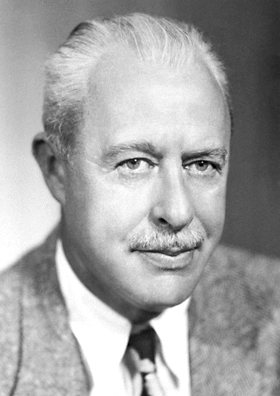Walter Houser Brattain (nonfiction)
Walter Houser Brattain (10 February 1902 – 13 October 1987) was an American physicist at Bell Labs who, along with fellow scientists John Bardeen and William Shockley, invented the point-contact transistor in December 1947. They shared the 1956 Nobel Prize in Physics for their invention. Brattain devoted much of his life to research on surface states.
Brattain earned a bachelor's degree from Whitman College in 1924, with a double major in physics and mathematics. Brattain and his classmates Walker Bleakney, Vladimir Rojansky, and E. John Workman were later known as "the four horsemen of physics" because all went on to distinguished careers. Brattain's brother Robert, who followed him at Whitman College, also became a physicist.
Brattain earned a Master of Arts from the University of Oregon in Eugene in 1926, and a Ph.D. from the University of Minnesota in 1929. At Minnesota, Brattain had the opportunity to study the new field of quantum mechanics under John Hasbrouck Van Vleck. His thesis, supervised by John T. Tate, was Efficiency of Excitation by Electron Impact and Anomalous Scattering in Mercury Vapor.
From 1927 to 1928 Brattain worked for the National Bureau of Standards in Washington, D.C., where he helped to develop piezoelectric frequency standards. In August 1929 he joined Joseph A. Becker at Bell Telephone Laboratories as a research physicist. The two men worked on the heat-induced flow of charge carriers in copper oxide rectifiers. Brattain was able to attend a lecture by Arnold Sommerfeld. Some of their subsequent experiments on thermionic emission provided experimental validation for the Sommerfeld theory. They also did work on the surface state and work function of tungsten and the adsorption of thorium atoms. Through his studies of rectification and photo-effects on the semiconductor surfaces of cuprous oxide and silicon, Brattain discovered the photo-effect at the free surface of a semiconductor. This work was considered by the Nobel prize committee to be one of his chief contributions to solid state physics.
On December 23, 1947, Walter Brattain, John Bardeen, and William B. Shockley demonstrated the first working transistor to their colleagues at Bell Laboratories. Amplifying small electrical signals and supporting the processing of digital information, the transistor is "the key enabler of modern electronics". The three men received the Nobel Prize in Physics in 1956 "for research on semiconductors and the discovery of the transistor effect."
On June 30, 1948, Bell Laboratories held a press conference to publicly announce their discovery. They also adopted an open policy in which new knowledge was freely shared with other institutions. By doing so, they avoided classification of the work as a military secret, and made possible widespread research and development of transistor technology.
Shockley believed (and stated) that he should have received all the credit for the discovery of the transistor. He actively excluded Bardeen and Brattain from new areas of research, in particular the junction transistor, which Shockley patented. Shockley's theory of the junction transistor was an "impressive achievement", pointing the way to future solid-state electronics, but it would be several years before its construction would become practically possible.
In 1956, the three men were jointly awarded the Nobel Prize in Physics by King Gustaf VI Adolf of Sweden "for research on semiconductors and the discovery of the transistor effect."
Brattain later collaborated with P. J. Boddy and P. N. Sawyer on several papers on electrochemical processes in living matter. He became interested in blood clotting after his son required heart surgery. He also collaborated with Whitman chemistry professor David Frasco, using phospholipid bilayers as a model to study the surface of living cells and their absorption processes.
In the News
Fiction cross-reference
Nonfiction cross-reference
- John Bardeen (nonfiction)
- Walker Bleakney (nonfiction)
- Physicist (nonfiction)
- William Shockley (nonfiction)
- Arnold Sommerfeld (nonfiction)
- John Torrence Tate Sr. (nonfiction) - Doctoral advisor
External links
- Walter Houser Brattain @ Wikipedia
